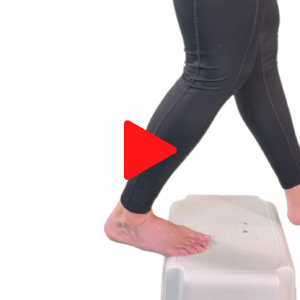Top 2 Exercises for Achilles Tendinopathy
Reading time: 2 minutes
Achilles injuries are all too common, yet standard exercise interventions often fail to deliver lasting results. If you have patients with recurring heel pain who want to try something new, this blog is for you.
IF
Structural changes in asymptomatic Achilles tendons are present in almost 25% of runners.
AND
These structural changes are associated with increased development of Achilles tendon pain within one year. (1)
Then
Strengthening the Achilles tendon through accelerating tendon repair becomes a primary goal in this population of patients. Today’s article will provide two simple exercises you may use in your clinic today to treat Achilles Tendinopathy. The first exercise will accelerate tissue healing by utilizing isometric contractions and agonist muscle strengthening. The second will add a minor wrinkle into a traditional exercise to force enhanced tissue movement between the three muscles affecting the Achilles tendon.
Exercise 1: Toe Pro
The Toe Pro Exercise accomplishes two tasks needed for tendinopathy patients.
Sustained Isometric Contraction
Chiropractors should seriously consider incorporating isometric exercises for tendinopathies. Tendons contain approximately 70% water and exhibit a fascinating behavior during isometric muscle contractions. As muscles contracts, an internal force squeezes fluid out of the tendon. (Imagine wringing out a wet towel) Fluid movement triggers a response in specialized cells known as tenocytes, promoting an accelerated process of tendon remodeling. So, isometric exercises stimulate a tendon's natural healing mechanism, making them valuable to your rehabilitation strategy. (2)
Agonist Strengthening
The ToePro activates the flexor hallucis and flexor digitorum longus muscles. These muscles significantly offload the Achilles tendon during the recovery process. Positioning the toe muscles in an extended position provides a nearly fourfold increase in strength gains compared to traditional exercises. (2)
Exercise 2: Eccentric Soleus Stretching
Healthy Tendons
The medial gastrocnemius, lateral gastrocnemius, and soleus muscles represent distinct anatomical entities attached to the Achilles tendon. In individuals with sound musculoskeletal health, there is a coherent coordination of contractions among these three muscles, exerting their influence upon the Achilles tendon. Each muscle unit contracts autonomously, instigating sliding interactions between the respective muscle units. While their contraction rates may vary, their collective action generates a synergistic impact on the Achilles tendon.
Degenerative Tendons
A remarkable distinction arises in Achilles tendons undergoing degeneration—upon the contraction of one muscle, all three muscles contract in unison. This abnormality can be attributed to prior injury or degenerative processes, resulting in restricted sliding dynamics among the muscle components. This impeded sliding, in turn, diminishes tendon remodeling capacities and expedites the progression of degenerative tendinopathy. (2)
*Much of this information is adapted from Dr. Tom Michaud. For a more detailed explanation of this and many more conditions, visit: www.humanlocomotion.com
Remember to brush up on assessment strategies and return-to-play recommendations within ChiroUp. Also, these two exercises are already included in your condition report sent to patients.
As Chiropractors, our ability to provide optimal treatment to our patients relies heavily on staying current with the latest breakthroughs and research findings for specific conditions.
The power of knowledge derived from research cannot be underestimated – it has the potential to revolutionize the outcomes we achieve.
In the vast ocean of information available, ChiroUp stands out as your guiding beacon, offering a concise perspective on the most recent discoveries on a consistent basis.
Do you want to see how we do it? Book a FREE demo with us today.
-
Cushman DM, Petrin Z, Eby S, Clements ND, Haight P, Snitily B, Teramoto M. Ultrasound evaluation of the patellar tendon and Achilles tendon and its association with future pain in distance runners. The Physician and Sportsmedicine. 2021 Oct 2;49(4):410-9. Link
Michaud T. NEW CONCEPTS IN MANAGING NON-INSERTIONAL ACHILLES INJURIES: WHY IMPROVING TENDON PRESSURE DYNAMICS AND INTERFASCICULAR SLIDING ARE ESSENTIAL FOR RECOVERY. https://www.humanlocomotion.com/new-concepts-in-managing-achilles-tendinopathy-why-improving-tendon-pressure-dynamics-and-interfascicular-sliding-are-essential-for-recovery/ Accessed 8/15/2023


